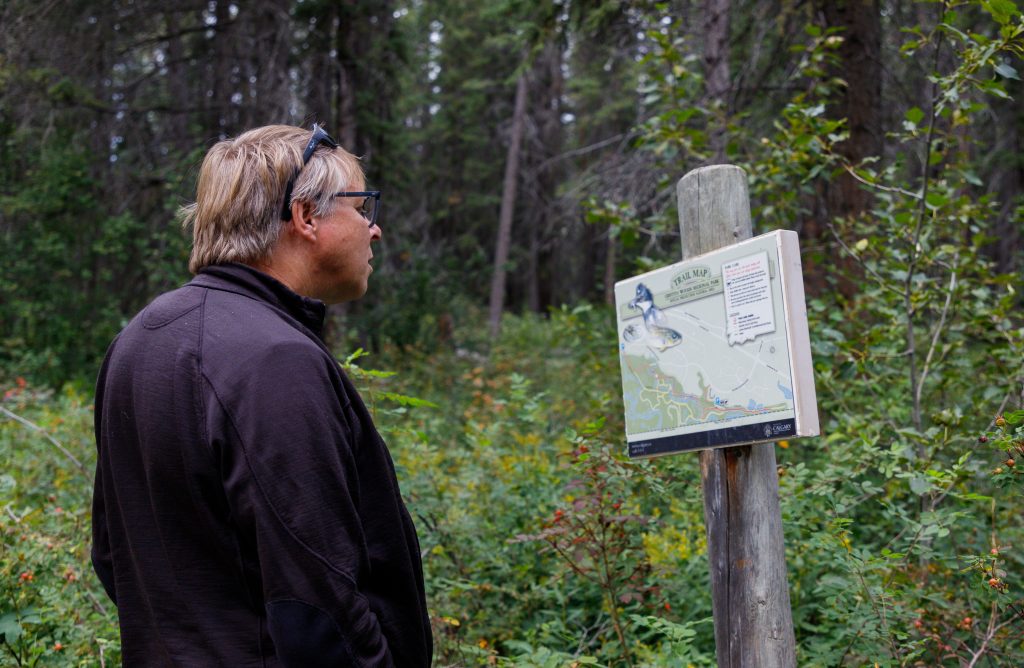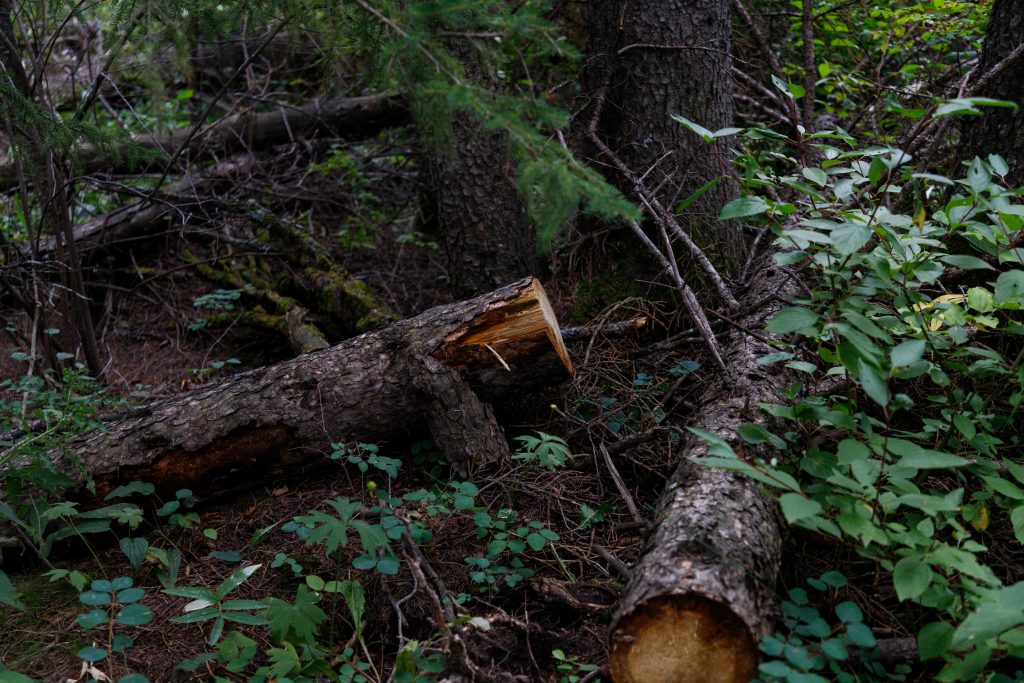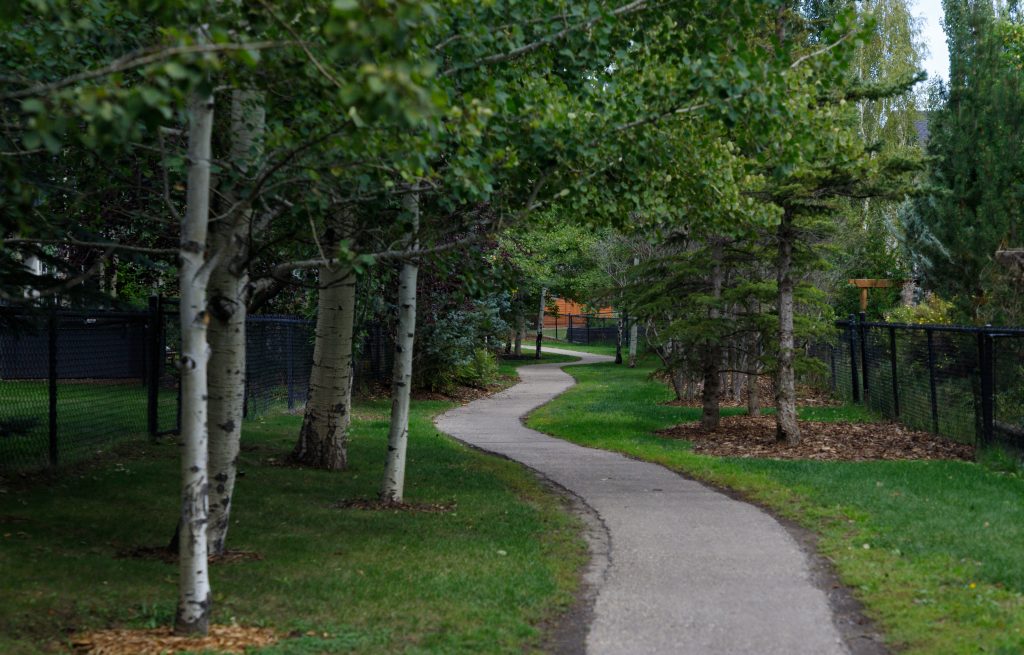Bark, branches, and dead trees litter the dark earth beyond the path of Griffith Woods Natural Environment Park in west Calgary in late August.
Ron Sparrow, a retired and formerly registered professional Alberta forestry worker, points at several trees and their branches that hang close to the ground as he walks and gives a tour.
“If it was springtime and this was dry, typically what happens is you end up with this slow-burning ground fire, but then it catches on to these (shrubs and bushes) and it burns up, and then it gets into the crown,” he explained.
He calls this ladder fuel, which is a link between plant life and other fire sources on the ground and the crown, the top of a forest.
The park west of the city is comprised of forest land, wetland, and grassland. While not native grassland, it is a recognizable and prominent landscape in Alberta. There are spruce trees in the park that are flammable during the fire season.
“Grass tends to burn quickly,” Sparrow explained.
“It’s like starting a fire in your fire pit: You don’t start it with just a chunk of wood, right? You put in some tinder, and you get it going … So, when you end up with these interactions, it would be that grass that would be starting things potentially, in that case.”
With only one way in or out of Discovery Ridge, Sparrow has been signalling to City of Calgary officials, warning it needs a fire prevention plan because, in his expert opinion, it’s at serious risk of a wildfire that would threaten residents. Other experts say this is emblematic of a larger problem in Alberta.
This comes as the Jasper Wildfire Complex, which burned a third of the town, was classified as held in the middle of August and the thousands of evacuees who fled in late July were finally able to head home.
The estimated insurable cost of damage is around $880 million.
Related Stories:
While walking, Sparrow notes grasses and shrubs, along with clumps of aspen and other natural forest life, that are highly flammable and can flare to an explosive fire.
“What you’ve got going on in Discovery Ridge is different fuel types, and there’s different topography, and the fuel types along the Altalink power line corridor is a graph that is volatile or flammable,” he said, referring to a power line in the area.
“But it’s flammable at certain times a year, and that’s that time is when it’s cured.”
He says the grass and shrubs dry in the springtime and late fall, and cure by collecting moisture. Also, being on a slope makes it more flammable and more prone to fire gathering because fire and heat move upward and can easily erupt into a fiery front and a faster-moving blaze.
“These would be challenging even if there weren’t a house there. And then you put in the advent of homes and people, that becomes challenging,” Sparrow said.
In addition to all the fire risk brewing, there is only one entry point into the neighbourhood, which makes fleeing for the 4,300 residents in an emergency potentially chaotic. This impending threat led Sparrow to bring his concerns to the city, something he has done repeatedly.
“We don’t want to see people hurt or worse, and you don’t want to see people lose their health, their belongings … or the contents of their home, what have you. You don’t want to see that,” Sparrow said.
“The other thing, too, is it’s bad for the environment … very, very toxic in the air pollution and in the cleanup.”

His solution is to see the area prepped with a years-long fire prevention plan that involves educating people on FireSmart and having other preventative measures like trimming parts of the forest that are old or a likely fuel source. He says this could cost millions.
Sparrow clarifies the goal of FireSmarting through managing vegetation is to remove fuels to prevent or slow any fire from spreading.
“I’m not entirely, uncertainly not averse to wildfires burning in the appropriate place, but this is not one of those areas. There’s too much … too many people, too many buildings. Not a place to be playing with fire,” he said.
Discovery Ridge’s layout could make a fire very challenging to deal with, comparable to or more so than Slave Lake and Fort McMurray, because of the singular road and the way nature is woven into the neighbourhood.
The Discovery Ridge Community Association has not responded to a request for comment.
Challenge in fire prevention in Alberta
Rick Arthur, who helped create the province’s FireSmart program, says there has been “cultural resistance” to implementing anything that would impact areas with forests and creating a fire prevention plan.
“You can reach out and touch the conifer trees from your deck, and people want that,” he said, speaking of Discovery Ridge.
“But, you want that until you’ve got a fire, and when you’ve got a high-intensity crown fire that’s moving towards your home and property, it’s far too late to start thinking about removing trees and trying to improve or reduce the fire risk.”
Arthur has nearly 50 years of experience in dealing with wildfire safety, and he says the trend of maintaining forests without intervention has grown in popularity, leading to a decline in grasslands and the habitats that exist in them, heightening the wildfire danger that has been plaguing many rural towns.
In his view, this has led to a change in forests over the years.
“I don’t see trees anymore. I don’t see forests. I see fuels,” he said.
“I look out on these landscapes, and I see how the different fuels are evolving, how they become much more flammable and much more dangerous.”
He warns that not disturbing nature for maintenance’s sake has impacted the province’s ability to have meaningful fire safety, as the idea that nature should be left alone has made prevention plans unapproachable.
“Within our society, our culture, we have a very strong preserve and protect mentality, so we create natural areas within our communities, or our municipal reserves are often growing up and they’re left undisturbed so that they’re more natural, and that goes way outside of the historic disturbance and historic management of these landscapes,” he explained.
Arthur says Alberta should follow the example set by First Nations, who cared for the land and tended to it. He says a lack of attention is leading to issues such as those in Jasper, as 80 per cent of the pine was damaged or dead from pine beetles.
“If you have fire danger indices that are going to burn that healthy pine with pretty high intensity — a crown fire, and then you damage that forest, and you have the same indices, it’s no longer just going to be a high-intensity fire. This damaged pine is going to burn with almost a nuclear force and intensity,” he said.
“That’s why you’re seeing … these 400-foot-high flames coming off the top of these trees.”
And while he cares and tends to forests and nature as a forester, he says land like grasslands can thrive due to the intervention of people. Without that intervention, vegetation and wildlife in those areas would cease to exist.

Ruping Luo, a conservation specialist with the Alberta Wilderness Association (AWA) says roughly 70-90 per cent of Alberta grasslands have been lost and are now an endangered land.
The International Union for Conservation of Nature has declared temperate grasslands, like the ones in Canada, the most endangered ecosystem in the world.
She agrees that forest encroachment is part of the problem with deteriorating grasslands, but she adds it’s a little more complex, saying development and infrastructure are on the list of issues clearing the land.
“Grasslands are largely maintained by disturbance, things like fire, things like flood, things like large animal movement, all of these things that keep these open planes open,” she said in a video interview.
“Without these disturbances, trees are able to establish and they’re able to slowly change the ecosystem and the soils and the species that you find in there.”
She says it’s been decades since much of the lands have seen any managed fires.
The loss of grasslands is having an impact on the species in the area, including bison, wolves, and the sage-grouse, an Alberta grassland bird that is down to a population of 60 — with 20 males.
Meanwhile, Arthur says other issues impacting forests include a growing population of Douglas fir mountain pine beetles, and them growing older and mismanaged, making more fuels. Heavy snow can also damage the aged forests.
“So two factors now: We have older, continuous coniferous forests, and we have damaged forests — damaged forests burned with greater intensity and lower fire danger indices,” he said.
Teamwork, time, and education needed to prevent wildfire

The city explained to Sparrow if anything were to happen in Discovery Ridge it could reach out to the province for assistance, but he says this might not be feasible because it may not be able to provide help if critical infrastructure is impacted at the same time.
“The province might be tied up on resources if they are tied up elsewhere,” Sparrow said.
Arthur notes the same thing, saying the fire response might take a long time to arrive — or worse — won’t come at all if there are multiple fires at the same time.
“You’ll be given an evacuation notice, and you’ve got a plan to get out, and hopefully … they’ll have support resources coming from either Alberta Wildfire or adjacent municipalities aiding them as well. But if we have multiple fire events, then everyone is busy and there’s less resources available,” he said.
While Arthur says cuts to Alberta Wildfire over the years, and the time frame of a response are a reason for municipalities to opt for fire prevention plans, he emphasizes the importance of shifting the approach to safety and education. In other words, rather than throwing money at the problem, it’s a matter of managing resources, like the parks budget for Calgary.
“We have to start thinking about, how are we going to manage this vegetation, not only the short term, but the long term, so that the vegetation remains healthy and less flammable, maybe less risky to the communities, and that may mean opening up and creating more grassland areas. And if we do that, how do we manage it?” he said.
“So Nose Hill in Calgary is a great example. We have lots of grass in there. What are we doing to reduce that fuel load, other than having the occasional spring fire that rips and races through uncontrolled? Can we manage it through grazing or through prescribed fire? Perhaps we can. Maybe not.”
In the meantime, Sparrow says it’s going to take a little teamwork among groups that include the city, the province, the community, Altalink, and Tsuu’tina, along with a dedicated commitment to ensure a plan is in place and executed at Discovery Ridge.
The City of Calgary failed to say anything concrete after attempts to secure an interview, except in a statement saying it is aware of wildfire risk, adding that parks, the Calgary Emergency Management Agency, and the Calgary Fire Department (CFD) are exploring plans.
“The City assesses fire risk within natural areas in our parks. Where required, we reduce fire risk through various actions that can include activities like removing an excess or build up of woody debris within an area,” the statement reads.
The CFD also says people should be mindful of FireSmart and implement fire prevention strategies at home, which Arthur and Sparrow also advocate for.
“We have to start looking at the values, at risk, the fuel surrounding our community, surrounding our homes. FireSmart begins at home,” Arthur said.
“You can do everything you want out on the landscape, but if you have spot fires that are or embers that are being transported and landing in your yard, and you have a lot of fuel ignition zones or fuel ignition beds there … it’s going to ignite, and it potentially could burn your home.”
More information on FireSmart and reducing the impact of fires in Calgary can be found online.
If you have any feedback on this story, please email alejandro.melgar@rci.rogers.com.